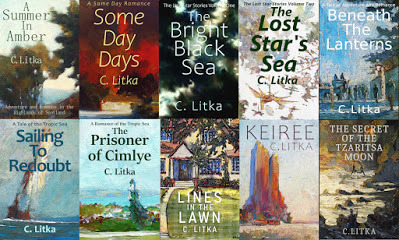C. Litka's Blog, page 47
January 30, 2021
First Draft of My Next Story Finished
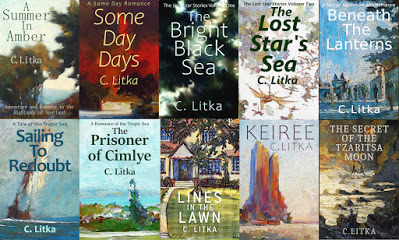
I am very happy to report that I finished writing my first draft of my next novel yesterday. For me, at least, the writing of the first draft is the heavy lifting part of writing stories. I’m always relieved when I have a complete story in hand, no matter how rough it might be.
I started writing on this story on 2 Nov 2020, so it’s taken me 89 days to write my 61,000 word first draft. It was rather a slow slog. Looking back to my files I can see that the first drafts of these books took:
The Prisoner of Cimlye, 49,000 words, 39 days (2020)
Keiree 30,700 words, 41 days (2020)
The Secret of the Tzarista Moon, 54,000 words, 34 days. (2020)
Sailing to Redoubt, 98,000 words, 64 days (2019)
Beneath the Lanterns, 117,400 words, 71 days (2018)
It seems that I’m slowing down… And writing shorter books. But then, I’m also getting older. In the case of my new novel, I had a story, pieces of the puzzle, and an ending (that I ended up not using) in mind before I started writing, but fitting the pieces of the puzzle together took longer than I would’ve liked. I ended up having to take a break in my writing several times because I had caught up to the point where the pieces were still up in the air. Eventually they fell into place – I hope.
So what is my new novel about? Well, it is an old fashioned who-done-it style mystery story. Why a who-done-it mystery? Because I like to write something a little different with every story I write and I haven't written this type of mystery story. Since it is an old fashioned mystery, I had to make sure that, not only did the pieces fit, but that they created an engaging mystery. I will also need to make the dialog and characters as entertaining as I can, since the story does not have desperate adventures to keep readers engaged.
The working, and most likely final title, is The Secrets of Valsummer House. It is another “Nine Star Nebula Mystery” with most of the cast of characters from The Secret of the Tzarista Moon returning for this direct sequel. We find Rafe d’Mere still in Pine Cove several months after the events of the first book and still a toaster and bot repair tech. Lieutenant JG Vaun Di Ai returns to the Agrilea Co-op, this time as a mere an intelligence analyst 3 “on a field trip” as she puts it. She’s been tasked with filling in some blanks, ticking off some boxes, and following up a few threads related to the events in the previous story. She has been strictly ordered to only tick off boxes and fill in blanks on the forms, or risk her Patrol career. Along with her return comes a rather mysterious robot in a crate for an owner identified only by a code, as well as a mysterious lady. Mix them together with the pirate prince of the Seven Syndicate, and you have the The Secrets of Valsummer House.
With the first draft done, I'll now go back and read through it several times, adding and playing with words to polish it up. I enjoy this process much more than writing the first draft. Given the nature of this story, I’ll need to make certain that my writing is as entertaining as I can make it, since it will be as important, if not more so then the mystery. This process will probably add between two to three thousand words to the final version. I expect the second and third drafts will take the better part of February, if not longer, to complete. Then the manuscript goes out to my beta readers for proofreading. At some point I will also need to work up a cover for it. So all in all, I expect to release The Secrets of Valsummer House in late March or early April 2021. Stay tuned for more details.
January 23, 2021
Riding The Rails
 Switzerland -- Lorirocks777 video
Switzerland -- Lorirocks777 videoOne of the great things about being old and retired is that you have all the time in the world to do whatever you want. If you can afford it. Many retired people like (or these days, dream) of traveling. Some take to the road in RVs to follow the sun. Others take grand trips abroad. The pandemic has kept most people stuck at home, but that doesn’t mean that you can’t travel.
Full disclaimer: I hate to travel. The stress of preparing and traveling outweighs its pleasures, since I have terrible memory so that I can’t relive my adventures. Plus, travel and adventure, I think, if for the youth, or books.
 Switzerland -- Lorirocks77 video
Switzerland -- Lorirocks77 videoGiven my attitude, I’ve found the perfect way for me to travel – in the cabs of trains alongside their drivers. Virtually, of course. All around the world, train drivers, and in some cases, passengers record their journeys in real time and post these video trips on Youtube. Over the last year and a half I’ve ridden in the cabs of trains for too many hours and thousands of miles throughout Great Britain, France, Germany, Switzerland, Austria, Slovakia, the Czech Republic, Sweden, and Japan. In addition, I’ve taken a few train rides in Poland, Norway, Belgium, Italy, and Greece. And I have trips through Romania and Bulgaria on my list for the coming weeks.
But it’s not the same thing as visiting these countries, you’re thinking. And you’re right. But it is a far more immersive experience than looking at static tourist pictures, or even Google’s street view – though that too is a good way to travel in your easy chair. There is something about the countryside streaming past for hours at a time that makes the experience almost real – not so much different than driving a car with the windows closed, as long as you don’t gawk around too much while driving. You see both sides of the rails and what lies ahead, until it streams past. Now, some of the older videos are pretty murky, but the drivers these days record in 4K, and while you lose some fine, fast moving details (at least with my internet connection) the experience is very realistic.
 England -- Don Coffey video
England -- Don Coffey video
Over the last year and a half I’ve gotten to know what Europe looks like without ever having to leave the house. I’ve kept records of all the rail lines I’ve traveled along, and have learned a bit of geography by looking up the cities involved in each video. Given my limitations in memory, I can’t provide you with much of a travel guide, but my advice is search out train rides that take you though hills and mountains – southeast France, southern Germany, Switzerland and Austria, but there are scenic train trips through most of the countries. I would avoid flat countrysides like you find in northern Germany and Poland, the Atlantic coast of France, and the eastern and southern parts of England. Not only does flat farm fields get boring, but the rail right of ways are often lined with trees so that you’re traveling down a corridor of green with only rare glimpses of the farm fields that you are traveling through.
An added bonus of riding the rails is that you get to see how railroads work – how the signals control traffic, and how traffic is managed. Don Coffey explains how the signals work in his videos, and you can translate that knowledge to all railroads – though the signals vary from country to country. But you can google those, if you care to.
 Paris -- Railtrotter video
Paris -- Railtrotter video
There are many ways to kill utilize your time when retired, and while mostsome people may find watching the scenery go by as exciting as watching paint dry, I find exploring these railroads interesting. These winter days, I have my bike inside and set up on a rack in the house. I’ve rigged a shelf on the handlebars to hold my tablet and spend my hour pedaling each day listening to music while I riding though the countryside of my choice on the rails.
Below are links to some of the train drivers who post videos of their trips:
England
https://www.youtube.com/channel/UC8LH7xMAyCSqpClAvTHwJRw/videos
https://www.youtube.com/user/benjie131/videos
France
https://www.youtube.com/user/mika67407/videos
https://www.youtube.com/c/Lionopointcom/videos
Germany
https://www.youtube.com/channel/UCowsdpGGcTcKhgurICOJERg/videos
https://www.youtube.com/user/747AnanasBoeing747/videos
Switzerland
https://www.youtube.com/user/lorirocks777/videos
https://www.youtube.com/c/RailwayEmotions/videos
Sweden
https://www.youtube.com/channel/UCVdYOTI_iTsXCVrRxniEHUw/videos
Slovakia
https://www.youtube.com/c/Vovlakusk/videos
Czech Republic
https://www.youtube.com/channel/UCempPZlZ55J1DLbSzVSw1LQ/videos
Train trips from around the world
https://www.youtube.com/user/Timsvideochannel1/videos
And there are plenty more.
Bon Voyage!
January 16, 2021
Life in the Fast Lane of Indie Publishing
 Chris Fox
Chris FoxThis will be my last posts featuring indie authors who share their success or lack thereof. I looked at Gideon Marcus who argued that professional editing was necessary, and the career of a part time writer, Ron Vitale. In both cases I suggested that financial success comes is most likely when the books are targeted at what avid readers are reading. In this post, I’m going to briefly talk about a “six-figure” science/fantasy and non-fiction author, 44 year old Chris Fox. He wrote a book on writing to market. From his Youtube videos, we will see what indie-publishing, looks like in the fast lane of Amazon/indie publishing.
You can view his Youtube videos where he talks about his business, how to do various aspects of writing and the business, plus inspirational pieces on his Youtube channel here: https://www.youtube.com/c/ChrisFoxWrites/videos
Chris Fox gave up a six figure programming job in 2014 to write full time. Since 2014 he has written 26 fiction books, plus various boxed sets, and 8 non-fiction books, related to different aspects of indie publishing. He writes in series:The Magitech Chronicles 7 books (science fantasy)Magitech Legacy 5 books (science fantasy)Void Wraith 6 books (space fleet/military sf)Deathless 5 books (urban fantasy)Solaris 2 books (YA superhero fantasy)Dark Lord Bert 1 book (Role Playing Game fiction)
His Non-fiction include:5000 Words Per HourWrite to MarketLifelong Writing HabitPlot GardeningSix Figure Author
He released 3 fiction and 2 non-fiction books in 2015, 5 fiction, 1 non-fiction book in 2016, 6 fiction and 1 non-fiction book in 2017, 3 fiction and 1 non-fiction book in 2018, 4 fiction and 1 non-fiction book in 2019, and 9 fiction books in 2020. In an effort to expand his income base, he has spent the last two year developing a role playing game based on his Magitech universe, and ran a kick-starter to get it off the ground. From watching his videos, I have to say that he appears to be something of a workaholic, putting in many hours a day writing, plotting, plus all the various aspects of running his business; creating and managing his ads, etc. In short, he’s the type of writer/entrepreneur that has the tools to succeed in indie publishing.
Below is the chart Chris Fox provides in his video about his 2020 earnings. On the top is his income, and on the bottom is his expenses. Boxes in green are improvements from the previous year. Boxes in yellow are declines in revenue from the previous year or increases in expenses. The chart is pretty straightforward. He offered paid consulting services to authors, and put together paid on-line classes, as many may successful authors do to supplement, or supplant their writing income. This year he decided to get out of that business, because it became too much of a hassle. He hopes to replace it with income from his role playing game. His business in incorporated, so that he pays himself and his wife, as his editor, a salary “Payroll & Retirement” so his net pre-tax income is what the limited liability company reported.
 Source: https://www.youtube.com/watch?v=67UCX...
Source: https://www.youtube.com/watch?v=67UCX...As you can see, 2020 was not a very good year, though one most indie authors would envy. He earned almost $100K, which would be damn good in Iowa City, but he lives in California, so we probably have to take the “damn” out of good, given the cost of living on the coast.
Ebook income was down something like 30% from 2019. While he spent $46,500 for editing and covers, most of which went into producing his role playing game. In 2019 he was spending an average of almost $10,000 a month advertising. He reduced that somewhat this year, cutting back towards the end of the year after finding more cost effective venues. Still, $104,000 a year for advertising is rather eye opening. Especially since Chris Fox is probably not one of the 100 top earning Amazon science fiction authors. At least I never saw his name on the list, before Amazon dropped that feature. (Though I may have missed his appearances.) He took a cut in pay this year, anticipating a big tax bill, since it was based on this $350+K income in 2019 and had a big increase in health insurance for his family.
However, looking at the chart below, I would have to say that there might be trouble in Bubble Land. This chart shows his monthly income from Amazon for 2019 and 2020 (I had to graft the two charts together from screen shots. Sorry for the quality. The blue is his his revenue from Kindle Unlimited page reads. The pink is his royalties from ebook sales, and the grey at the bottom is paper book royalties. The scale along the side are in increments of $5,000. I have added the books Chris Fox released in this time frame under the graph.
 Source; https://www.youtube.com/watch?v=zfsYX... & https://www.youtube.com/watch?v=PoXOT...
Source; https://www.youtube.com/watch?v=zfsYX... & https://www.youtube.com/watch?v=PoXOT...In previous videos Chris Fox pointed out that sales go up when you release a book, and then slide back down over the next three months, suggesting that frequent releases will pay dividends. Beginning in April of 2019 you can see that he released a series of two new novels and a non-fiction book along with a big boxed set of his best selling books at a good price and saw his sales soar to almost $30K in one month and $25k in the next, only to taper down when he stopped releasing new books. However, in 2020 he wrote a million words, and, as you can see from the chart, released books at a rapid rate, indeed, at more than one a month in the last four months of the year, which produced only a minor bump, and given the number of new books, he was basically treading water. You can blame it on 2020, or the election, or whatever, but if I were him, I’d be concerned.
I have long wondered what is the half-life of an indie publisher. How long can they sustain their popularity before readers, with virtually unlimited options, move on, either because they are tired of a writer’s style and/or formula, or simply lose track of them with so many alternatives. Some of these readers read multiple books a week (or a book a day in some genre) and so that even if an author releases a book every 3 months, the readers will have read several dozen books in between. It is easy to imagine that even with the best intentions, readers never get around to reading an author’s latest book, and then lose track of them altogether. It seemed like around 2016 or so, a lot of the early successful writers had faded away or burned out. Some may have taken on new pen names and carried on, but I have a feeling that a six or seven year career in indie publishing’s fast lane may be the norm. And Chris Fox is starting his seventh year… He’s still making over $10K a month, so it’s not time to panic, but when releasing five books in four month barely moves the needle, well, one has to wonder. And he might, indeed, be wondering, since he’s planning on releasing an epic fantasy series in 2021.
Changing genre might be one way to revive revenue, but it is not without its risks. Hardcore fans want the same thing, over and over again, and may not want to move on to epic fantasy. While on the other hand, epic fantasy is a very competitive genre, so it may be hard to break into, even for an established writer. We’ll see.
In any event, I think it clear that the fast lane in indie-publishing is not Easy Street. It takes a lot of work, and continued success is not guaranteed.
January 9, 2021
Back on the Soap Box -- Target Avid Readers
 Ron Vitale
Ron VitaleThis week I’m back on my soapbox and conversing with the clouds about the importance of writing a competitive product if one wants to have a chance of making money in self-publishing. Once again.
One of the writers I follow, Ron Vitale, posted his “2020 Year-end Wrap Up: Full Sales and Expenses as an Indie Author” post, which you can read in full, here: Blog post And if you are thinking about self-publishing, you should. Along with his other six similar posts covering his experiences in publishing from 2013 on.
Like the vast majority of authors, self-published and otherwise, Ron Vitale has a full time day job that pays the bills. His night gig, or in this case, his early morning gig, is writing and publishing fantasy, SF and self-help books, which he started doing in 2011. He has published 17 books, 13 works of fiction, and 4 non-fiction books over the course of the last nine years. Over this time, I think that he has tried just every tactic and strategy that has been promoted as the key to success in self-publishing – save perhaps the most important one. “But,” as he writes, “when I tally up all the numbers over the last nine years of sales, I’ve still failed as a business.” He goes on to say that “I’ve lost money. I’ve made mistakes… but kept moving forward. Since I started publishing books back in 2011, I’ve built up a nice base for my intellectual property. Each book is a unique product that I can morph into other properties: audiobooks, eBooks, (single or box sets) print, licensing deals, etc. I may not have made a profit yet, but I’m in this for the long haul.”
 source: https://www.ronvitale.com/blog/2020/1...
source: https://www.ronvitale.com/blog/2020/1...Fair enough. But let’s look a little deeper. Above is a chart of expenses vs sales for each year. Looking at that chart, it appears that his publishing venture has lost somewhere north of $10,000 over the last nine years. I imagine that there are many people who spend well over $1,000 a year on their hobbies, so in that light, and his long term goals, he didn’t lose an extraordinary amount of money self-publishing his work. And he is growing revenue and shrinking expenses, so things are moving in the right direction, but clearly it is a long haul to making a business out of it.
If you’ve read my previous post, I’ve argued that to sell books these days, self-published authors need to identify both the type of readers, and the type of books they are reading to successfully sell books for folding money. He writes “stories about people who overcome their past trauma to grow and heal. Writing is therapeutic for me.”In other words, he writes what he wants and feels need be written. Which is great. So do I. But is there a market and a business to be built on books with that focus?
Below is the sales chart for fantasy books from Author Earnings’ presentation to the 2018 SFWA Nebula Conference (The complete presentation here: http://authorearnings.com/sfwa2018/ ) The chart breaks down the sales of fantasy books by sub-genre and who is selling them. The vertical lines represent 2 million copies sold. I’ve annotated it to show where Ron Vitale’s fantasy books fall on it.

I should point out that the best selling sub-genre are also the most competitive as well, so that writing in the best selling sub-genre is no guarantee of success, and you can find success in the slower selling genre, if you know and produce the tropes, story beats, blurbs, and covers that the most successful authors have perfected.
He classifies the Witch’s Coven Series as epic fantasy. I’m not a fantasy fan, nor have I read these books, but oneof the signs that an author knowswhat they aredoing, is that theyknow the expectedword count for the genre they[rewriting in. Both of the Witch’s Coven books come in under 200 pages, in a genre where door stopper books are the norm. The other epic fantasy book, Dorothea’s Song, alternates between a modern day school boy, and his fantasy creation, which I suspect falls outside of the expected norms of epic fantasy.
He classifies Cinderella’s Secret Witch Diaries as fairy tale retelling. Cinderella is a Disney Princess these days. While I have seen other modern takes on the Cinderella story, a story that destroys the “and they lived happily ever after" fairy tale story beat would seem to be a tough sell.
The Werewhale Saga is a dark fantasy that has the children of Herman Melville’s Captain Ahab going off on adventures to dark and dangerous islands. Do they make students read Moby Dick anymore? And do the fans of Moby Dick read self-published fantasy? It seems to be a rather iffy proposition.
The Red Door Diaries is a gaslight fantasy set in a brothel. Well, he doesn’t have a lot of competition in this category. Nor readers.
Below is the science fiction sales chart from the same presentation. Note how much better fantasy sells than science fiction.

His two science fiction books, The Jovian Gate Chronicles, are tied into his Cinderella stories, featuring Cinderella’s time traveling daughter in a space opera were humans are ruled by the Catholic Church and the Confederacy who meet aliens who claim to be prophets of God. The second book is a collection of short stories. In short, they seem all over the map.
My take away from Ron Vitale’s report is that you can do all the right things, but will fail unless your product is spot on the formula of whatever sub-genre you’re targeting. You can write all the artisan books you want, but if you want a chance to build a business on writing, you need to write fast food books – familiar comfort reading delivered fast – every couple of months.
Ron Vitale started publishing in the gold rush boom years, when it was all new, and everyone had a chance to make it big. But those days are history. Tens of thousands of books are released every month. And even if you write to the formula of your sub-genre, you still need to catch their eyes. And these days that takes money – thousand of dollars.
In the next installment, we’ll look at a Cris Fox’s 2020 results. Cris Fox makes a good living self-publishing a variety of fiction and non-fiction books. He also posts and talks about his income and expenses every year. In his report we will see what it takes to make folding money in self-publishing.
January 2, 2021
The eBook Market Visualized
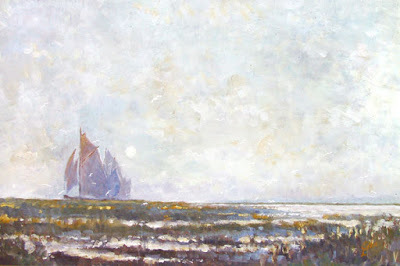
People sometimes ask me why I don’t sell my books, though, truth be told, few people know or care that I write books. Still, those that do have asked me that question. I tell them that these days self-publishing is a big business, and you need to invest lots of money, if you want to have a ghost of a chance of making money in it. And unless you approach it systematically as a business – identifying the markets that move the most product and can produce a competitive product rapidly and relentlessly, you probably are not going to make money no matter how much you spend. Essentially you must be a business person first and a writer second – if at all. You can always hire ghost writers to produce the books you want, as long as you know just what sells.
In my imagination I picture the ebook market of Amazon, and other ebook retailers, as a vast marsh covered with reeds as far as the eye can see. Each reed is a book. Millions of them. The money that flows through this marsh can be seen as water. Let’s cross this marsh.
At the fringe of this marsh, the ground is hard and dry, the reeds brown. These are the books that people write for themselves, with either very limited appeal for one reason or another. And as a result, no money in the shape of water has reached them. They’ve never sold a copy. We push on, and eventually the ground becomes moist. You don’t see any water, but the reeds are thick and green. These are the books that have sold a few to a dozen or two copies, mostly to relatives, friends, and a few explorers of this wilderness of books. They may not be much better than the dead reads, but their authors come from big families, or have a lot of friends. In both of these cases there are no doubt true gems of books, but they are lost in the millions of reeds.
We walk on, and on, through these millions of reeds. Slowly the ground grows softer and eventually, there’s a little pool of water in our footprints. We’ve reached that part of the marsh where the reeds are books that have sold a hundred copies. These are the books of writers who have persisted, gotten better at writing, and have become more savvy in the trade. They may be on to something. Or not.
A few steps further and now there’s a thin sheen of water over the surface. We’ve reached the part of the marsh where books have sold maybe 500 copies. I’ve seen it reported that the average book sells 250 copies, so these books can probably considered success, if modest ones. They’re not paying many bills, and may not have earned out their publisher’s investment in covers, editors, and advertising. But they’re in business, anyway.
Just a step or two further, the water’s up to our ankles, but we can push on no further, as we have come to the shore of a swiftly flowing river. This rushing river is very narrow, but deep, the reeds submerged beneath the rushing water. We’ve reached the best sellers, awash in money from purchases and page views on Amazon’s Kindle Unlimited. The reeds under this surface are selling five, ten or more copies a day, earning their authors thousands of dollars a year. These are the books that the avid ebooks readers favor, and consume one after another.
Now we take to the air, like a bird. And looking down, we see not one of these narrow rivers winding through the broad flat marsh, but several dozen, perhaps. These rivers are the genres, or sub-genres that the avid ebook readers crave, and we can divide the marsh into sectors – romance, fantasy, science fiction, thrillers, etc. And through these sectors, several of these narrow rivers flow. If you can discover the formula of these best selling books, replicate it, and then bring it to the attention of the avid readers, you too could plant your reed of a book in the riverbed of these swiftly flowing streams, and make a lot of money. It’s almost that simple. But I have a feeling that it takes a little magic as well – either in the writing, and/or the blurb, and/or the cover, and/or the advertising to make it happen. And probably just pure luck as well. But you have to reach the banks of those rivers and plant your reed before all that can happen.
Unless you were born with a rare gift – the books you want to write match the books the avid readers in your genre want to read – and luck follows you like a dog you’ve raised from a puppy, writing books that sell well will be hard work. A job that demands a lot of hours, but doesn’t pay you a wage every two weeks. The rewards may be great, but so are the risks.
I cheat. I write the books I want. I don’t do any market research. I don’t spend any money on my covers, editing, or advertising. So, viewed as commercial products, you’ll find my books where the soil is merely moist. But because I give them away, my books perform as if they were a step or two or three away from those rushing streams. I was born with a rare gift. I’m not ambitious. Whereas most authors feel that selling books is essential to their self-image as an author. I’m able to embrace my amateur status and not discount my talent because I don’t sell my books for money. As a result there are some 40,000 of my stories on thousands of people’s devices these days.
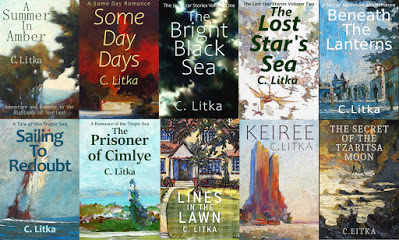
December 26, 2020
Is Professional Editing Worth It In Self-Publishing? A Case Study
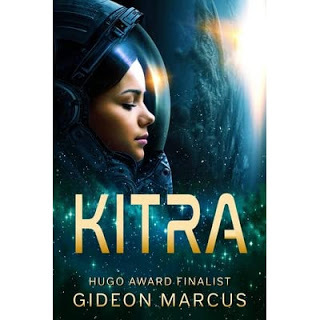 Cover for Gideon Marcus's book Kitra via Goodreads
Cover for Gideon Marcus's book Kitra via GoodreadsLast week, I argued that professional editors were not necessary for self-publishing authors. I feel that the fate of the story has largely been decided before it would ever get to an editor. To produce a commercially viable book these days, it must be targeted at a commercially viable readership, delivering the tropes, the story beats, the cover, and the blurb that those readers expect. No amount of editing will sell a story by someone who doesn’t know how to write, nor a well written story, if the writer has not done their research and/or lacks the resources and/or know-how to market their book.
This week I’m going to use Marcus Gideon’s YA science fiction book Kitraas an example of my premise. As I said last week, he drew the short straw because I recently read his forceful advocate of professional editing, has published a book, and has shared some sales results that will allow us to examine the proposition.
So to start, here is Marcus’ “get an editor” pitch:
“I’ve written thousands and thousands of pieces in my life. I compose almost as effortlessly as breathing.
I always have an editor go over my work. Sometimes several editors. You should too.
Here’s why:
When you have an audience of one, you know exactly where your characters are, their motivations, their traits. You’ve got a clear idea of the universe. You know what you’re trying to say. Until someone else reviews what you’ve written, you don’t know if “someone else” knows what you’re trying to say.
So for anything you want to publish, and especially stuff you expect to get paid for, you need an editor. And not just any editor. You need, at the very least, an experienced writer to bounce your ideas off of. Otherwise, the best you’ll get out of them is a vague, “I liked it!” or a “It needs something, but I don’t know what.”
It may be tough finding the editor that works for you, someone who 1) you can work with, 2) offers good advice, and 3) is affordable. I’m still reeling from the loss of one of my favorite editors, who is coping with a chronic illness. But when you find the right editor, your work will ascend to the next level.
Finding the experienced editor (or several) is the first hurdle. The second is your ego.
No one likes to be told that their magnum opus doesn’t work. No one likes to spend months pouring themselves onto a page only to have to rewrite the whole damned thing.
Let me tell you something: when starting out, you will spend more of your life in editing than writing. If that bugs you, you’re in the wrong business.
Sure, eventually you’ll get good enough that you can work out a lot of your bugs prior to the editing process, but that first book? It’ll go through the wringer.
Kitra, for example, essentially went through four drafts until it was good enough for the public. It’s doing pretty well. Folks like it. If I’d released any of the earlier drafts?
Three sales on Amazon.”
He offers some valid points. Every writer would likely benefit from some sort of feedback on their story. It should be proofread. But does it need a "developmental editor" to go through and fine tune the story similar to the process in traditional publishing? And is it worth the money?
Marcus Gideon is a professionally published writer. He is the proprietor of the website Galactic Journey, and the small publishing house, Journey Press. The quote comes from a blog entry entitled “Time in Service” on the Journey Press blog section. You can find the complete blog post here: Journey Press Blog
Strictly speaking, Marcus is not a self-publishing author, but the founder of a small press that published the works of others, besides himself. His SF anthology Rediscovery features stories by women SF writers from the 1950’s & 60’s. Marcus is well known in SF circles, and the subject matter of this book generated a lot of free publicity upon its release in SF circles. Much more than any self-published author, no matter how popular on Amazon, could expect with any new release of their own. In addition to publishing Kitre, he has also reissued a 1964 B-side ACE double story by Tom Purdom, I Want the Stars. For some reason. He has spent the last year or more building up a network of some 500 independent bookstores that offer his books. And owning a website that is visited thousands of times a month which he uses to promote his books, I think it is safe say that he’s pretty solid on both the distribution channel and publicity side of selling books. So with those very important ducks in order, you would think that the sky’s the limit for his professionally edited debut novel. But, ah… not so much.
As it turns out, the YA non-dystopian, non-post apocalyptic science fiction market is not a vibrant market, according to Alexa Donne, who should know. She has had two YA non-dystopian, non-post apocalyptic science fiction novels traditionally published, and knows the YA market backwards and forwards. She offers weekly videos on that market on Youtube which you can find here: Alexa Donne Videos In several of them she has talked about her experiences as a YA non-dystopian, non-post apocalyptic science fiction writer. From what I could gather, a runaway best seller in that market would be a disappointing release for a YA fantasy book. Fantasy sells, while non-dystopian, non-post apocalyptic science fiction books are lucky to sell a couple thousand copies. Whether this is because there is no interest in them in the YA audience, or because traditional publishers don’t know how to promote them she feels is an open question. But the fact is that the ceiling is low for the type of SF story that Kitra represents. And Marcus seems to have been aware of this, since he writes; “Let’s face it — YA is often associated with dystopia, grim stories where the evil Queen or the fascist government is the big bad. Kitra is a hopeful story, one in which teamwork and perseverance see the characters through. There’s a hunger for these kinds of stories now.” That last line strikes me more as wishful thinking that market research. In any event, his sales so far fail to justify that optimism.
Kitrawas release in April 2020, at the start of the pandemic. Prior to the pandemic, he reports that his company was selling around 200 books a month – which would be the Rediscovery title with its significant free publicity. During the pandemic, sales have dropped to around 70 copies a month, split between the three titles. Much of that decline, can certainly be blamed on the pandemic. Still...
Both versions of Kitra are offered on Amazon. The ebook version on Amazon’s bestseller list is ranked in the 1.5 millions when I looked it up for this post. That translates to a copy every month or so. Trust me, I know that from experience. The paperback version is in the 2 millions, so it has sold a non-zero number of copies on Amazon. These are in line with the results you could expect from a debut novel without an Amazon focused advertising budget.
On Amazon, Kitrahas garneredsixreviews from actual purchasers of the book, four 5 star, two 4 star reviews in eight month. It has a total of 22 rating/reviews, but theother reviews likely come from free copies of the story given in exchange for reviews. This technique is commonin the trade to spur sales withlots of reviews upon release. However, there are too many incentives for all parties in the system tofavor good reviews, soI don’t consider them completely valid. It also has 31 ratings on Goodreads, with 26 reviews for an average of 4.06 stars, again with at least half the reviews coming from free copies, plusMarcus Gideon’s own 5 star rating.
Sothe book is well received. I’ll leave credit for how that is divided up between the author and editor to them.However, even with good reviews, I think it would be hard to make the case that its professional editing has done much for sales. Certainly not enough to overcome the handicap of writing a book for a small, low demand market.
All of this is not to say that Kitra is a failure. It is a modest success to date, and has many years to earn out its cost. And, with future sequels,it may do… Okay. Sequels can stir interest in the previous volumes, but theyinevitably sell less with each sequel.
However, if you’re in the business of writing and publishing stories to make folding money, I think it is fair to judge a book as a product and a product by the money it earns. As a product, Kitra, with all its editing, does not seem like a product with much promise by that metric. Not because it is poorly written or edited, but because there’s relatively little demand for this type of story. The publishing business, self-publishing or otherwise, is a very competitive business, and I don’t think anyone isgoing to succeed at making money init, if one doesn’t shot for the stars. And that means identify and mastering a potentially lucrative market, and writing to it.
SoI say, first know your audience, and then trust your talent. Critique partners, and beta readers can offer much of the feedback an editor would provide. If you have money to spend, spend it on a good, proofreader and a cover artist.
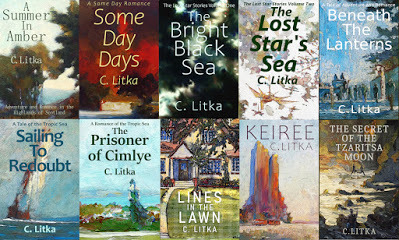
December 19, 2020
Are Professional Editors Useless in Self Publishing? (Part 1)
People are always telling self-publishing authors who dream of making money writing, that that they need to hire professional editors to lift their stories up to a professional level. In most cases this is pure BS. I understand that the big publishers are laying off editors right and left, and that editors need jobs, but well, life is hard. The last thing a self-published author needs to do is to spend money on a professional editor. That money is more wisely spent elsewhere. Like in advertising.
Why? You ask. You did ask, didn’t you? Well, the simple reason is that it comes too late in the game to save the day, if the day needs saving. Editors in traditional publishing have hundreds of manuscripts to choose from. They, and the marketing department, can select from these hundreds, the ones with the greatest potential to sell a lot of copies. However, when a self-publishing author hires an editor, they must work with what that author has written, and by that time, the story's fate is already sealed. So, short of rewriting it, an editor isn’t likely going to make enough of a difference to change this fate.
To understand why this is, you have to go to the head of the production line. If an author is going to be commercially successful, they need to identify a market that has the potential to provide a profitable business for the writer. It doesn’t have to be the largest, but it needs to have a large enough pool of avid book buying readers to provide the potential for selling thousands of copies.
Having identified such a market, an author needs to study what exactly this audience expects in the books they buy. What are the tropes and story beats that all the best sellers in the genre serve up? What is the formula? This is discovered by reading, and studying the bestsellers with an eye to their similarities and structure. Once they have deciphered the formula, they then need to write to that formula, giving it their own distinctive variations, while making sure that readers get what they expect to get.
If an author has done their homework and understands their potential readers – and written a story that meets their expectations for both the story and the basic quality of writing – they shouldn’t need an editor to polish it further. The fact is that if one is writing for avid readers, the literary bar isn’t all that high. Potboilers sell, and always have. Avid readers are not discerning readers. They don’t have the time for being fussy.
I should mention here that we're talking about editing, not proofreading, which is something different. Some sort of proofreading to eliminate typos is a necessity. Polishing prose isn't, if the story meets the expected standard of the genre. Which, if the homework is done, it should.
Plus there are more pressing issues that need a self-publisher's money. The main one is getting readers to notice their books. What good does it do you if you have the perfect book but no one can find it? The money spent on editing is likely better spent on advertising and promotions, which are sad necessities in self-publishing world these days. Without advertising of some sort, one's chances of making more than pizza money in the trade is close to nil. So, in that respect, money spent on an editor is actually counter productive.
Don’t believe me?
Well next week I’m am going to use a concrete example of a professionally edited book that targeted at a relatively small market, namely, YA non-dystopian, non-post apocalyptic science fiction. It’s a market that even big traditional publishers have a hard time selling more than several thousand copies – at best. The book I’ll use is Kitra, by Marcus Gideon. Marcus draws the short straw because he is the most recent advocate of professional editing thatI’ve come across. And he happened to provide some ballpark sales figures for his professionally edited book which we can use to get some insight into how much, or how little, professional editing drove sales of his book.
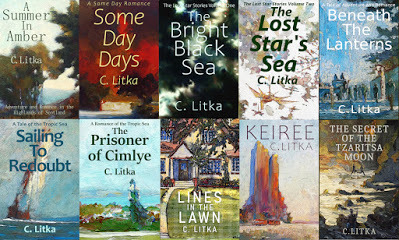
December 12, 2020
Perfection(ish)
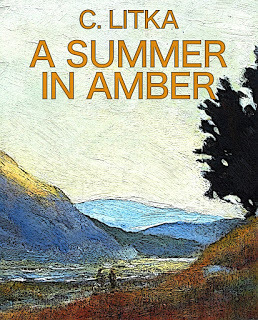
I can’t spell. Never could. Still, my attitude is that the only way someone knows that I misspelled a word is that they know the correct spelling and thus the misspelled word did it’s job. It may’ve taken a split second to translate it on the part of the reader, but it still conveyed the meaning of the correctly spelled word. Which is all you can ask of a word. I may’ve used a crowbar to hammer a nail down instead of a hammer but it got job. You gota work with what you got.
I’m not a person who learns by rote and memorization, and there is no way to learn spelling, or indeed the ins and outs of the English language except by rote memorization. And to put it bluntly, the English language is a hopeless clusterfuck. There is no logic in its spelling, and for every so-called rule, there are exceptions, so there are no real rules. No real guides. Perhaps the most annoying thing about the English language is that some people think its unalterably sacred. I find it hard to believe that the gods of the English language handed down the word “nevertheless” to us. (I Googled it to save your the trouble. It likely comes from the Middle English word neverthelater and means notwithstanding.) Nevertheless, I have to believe that at some point some Middle English people just started stringing the phrase “never the later” altogether, whether the high priests of the English language objected or not. And then someone, some time later, just slipped nevertheless into its place. Who knows if the high priest of English objected or not. If they did so, they failed to put a stake through its heart.
In that spirit, I think I’m going to invent a word myself. A useful word – atleast. Atleast is atleast as useful a word as nevertheless, if not more so. The gauntlet is down. And I don’t care if there’s a red line under it. There’s a red line under “neverthelater” as well. And that’s a good Middle English word.
Given my attitude, one has to wonder how it is that I’m a writer. Or perhaps, how good a writer I am.
I’m okay at it. It’s a journey not a destination, but we’re on the road. As for my lack of qualifications in the English language, well I’ve got a crutch. A computer to do the spelling for me. I hate writing by hand days. But on a more general note, my attitude is that I am not an automobile mechanic and yet I can drive a car. All the illogical messiness of the English language can stay under the hood, as far as I’m concerned. I don’t need to know it. Sherlock Holmes didn’t want to clutter his head with useless knowledge, like the earth circling the sun, for fear of filling it up with useless knowledge at the expense of useful knowledge. That’s my attitude as well. In the place of rules and diagrams of sentences, I have read maybe two thousand books in the past half century. And from that experience I have distilled what I think is good writing looks and storytelling looks like. And I try to apply what I think is good to what I write.
Attitude is one thing. But it takes one only so far. You gotta respect your audience as well.
In 2015 I self-published the three novels I’d been working on during the previous five years, starting with A Summer in Amber. In doing so, I decided to lay my strengths and weakness as a writer out there for anyone to see. It wasn’t a decision that I took lightly. However, I realized that there was no great risk in doing so. If I did made a fool of myself, I’d only be a fool in the eyes of a few, maybe a hundred, strangers. Nothing ventured, nothing gained.
In doing so, I learned a lot. One of my major lesson was I discovering just how blind I am to typos. I read, like most people, what I expect to read. Just as long as the shape of the words more or less match expectations, I'm good to go. And because they were my words, I hardly had to read them at all. As a result, I would give my wife what I considered a clean manuscript to proofread and she’d find five or six hundred or more mistakes. And still not catch them all. And I didn’t help my cause by making revisions after the manuscript had been proofread. So there were a fair number of typos in my first books, though, as I said, many hundreds less that if left to my own devices. This sad fact was mentioned in the early reviews, which was fair enough. However, what was encouraging is that they were, for the most part, still good reviews, so I knew that I’d done the most important thing right. I just had to do other things a lot better.
In the five years since I first published these works, I’ve made many revisions to correct those problems. I had a year’s worth of Microsoft Word that had a more robust grammar checker than the LibreOffice program I use to write. I went through the books I'd written at that time using Word to find mistakes we’d missed. It helped, but the real solution came when some of my readers stepped up and volunteered to send me lists of the mistakes they found when reading my books. And some of them have stayed on to be volunteer beta read for all of my subsequent books as well.
The process is rather eye opening.
My wife, a retired high school teacher who knows a lot more about English than I do, is my first proofreader. And as I said, she finds the first five, six, seven hundred or more mistakes I make. After making corrections, I send the manuscript off to my four or five beta readers. They find an additional 50 to 100 mistakes. They all get the same copy, and yet, there is remarkably little overlap in the mistakes each of them find. It seems that everyone reads a little differently, and each get tripped up by different words. The process, however, delivers a pretty clean copy, and I am ever so grateful for their efforts. I don’t get complaints about all the typos these days, thanks to them.
However, I want to give my readers the best possible experience (within my budget) and I noticed that while typing emails in gmail, it would highlight awkward grammatical phrases, and such. I wondered if Google Docs would do the same thing. So I uploaded my latest book to Google Docs, and sure enough, it worked the same way, finding double words, missing words, and those correctly spelled wrong words that slip in, the its and it’s, where and were, discrete and discreet – my usual suspects.
As a result of this experiment, I’ve spent the past week running all of my works through Google Docs and making corrections that this process found – when appropriate.
I found many things to fix in my earliest works, though almost no misspellings. But in those early works, I wrote in a rather telegraphic style. I wrote them how I heard my characters speaking, and I often skipped little words like “a” or “the” that were almost understood with out speaking in speech. And I would think that they’d not be missed, when in the flow. However, this time I put them in.
I found a few other interesting points going through my work. Google prefers that my characters look “at” each other, while I prefer that they look “to” each other, i.e. “I looked at her” vs “I looked to her.” I also found that Google prefers that when a character did something, did another thing, and then says something, it prefers it written as, “I looked down, jumped back, and exclaimed, “Hey, that’s a snake!” Whereas I prefer prefer to choreograph the action, i.e. “I looked down, and jumping back, exclaimed, “Hey, that’s a snake!’ I kept my way in both cases.
These revised versions of my books are now available in all the bookstores. My Google books now have the 2020 covers as well. If you’ve already read them, it’s water over the dam. But if you have some sitting around yet to be read, swap them out for the new editions, if you can. I’m confident that they are now perfect(ish). At least as perfect as they’re ever going to be – though I will, of course, make any corrections readers send to me.
Bottom line; no looking back now. They are what they are. And I think they’re good enough for me to sleep well at night.
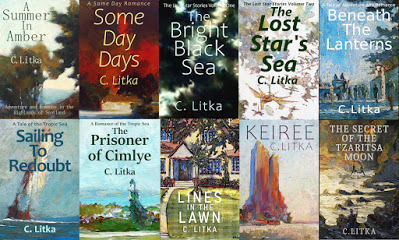
December 7, 2020
All But Keiree are FREE on Amazon
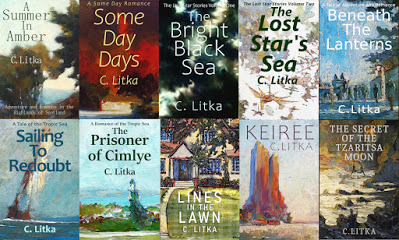
Them algorithms. For some reason Amazon has decided to price match all my books, save Keiree, and have reduced the ebook versions to FREE. I can't say how long this will last, but if any Kindle readers have been hesitating to sample my books, now is the time. The cool thing is that most of my most recent books, Sailing to Redoubt, The Prisoner of Cimlye, and now The Secret of the Tzarista Moon are all FREE for once.
I've written a whole blog post on why I sell my books for FREE when I can. The short story is that I don't spend more than $50 out of pocket on any book -- for paper copies to my beta readers -- and my incidental sales cover much, if not most of that expense. So I can afford to sell books for FREE and not end up in the poor farm.
While writing a book takes a lot of effort, it's not work. It's fun. I don't need to be paid to have fun.
My attitude towards books is that if I want a book, I'll by the paper version. But if I want to just read a book, the library is my first choice. So, for me, reading a book is a free experience. This makes my free price on ebooks seem natural to me, since I think ebooks are reads -- not books in the physical sense.
Amazon decides when and for how long they will price match books. I don't know how long the free prices on any of these books will last. So get'em while you can.
December 5, 2020
My Library -- House Plan & Architectural Books

Some thirty years ago now, we managed to scrape together a down payment for a house. After looking at several houses in town, and realizing that we’d likely have to not only make do with one feature or another that we weren't completely happy with, but would also need to put money into these older houses on an ongoing basis to fix this or that, we decided to build a modest new house. One that would not need modernization for several decades. And since we were going to build a house, we might as well design it to suit ourselves. Which we did, having a professional designer draw up the actual plans and blueprints. All of this sparked an interest in house designs and I began to acquire books with house plans to see how things could be done.
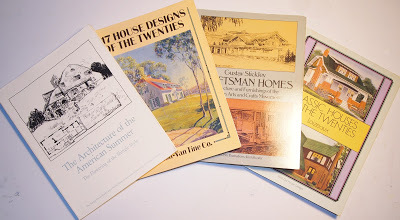
Dover Books offered – and still offers – a ton of books with old house plans from the turn of the last century to the Twenties and Thirties. Dover Home Plan Books Many of these books are reprints of house plan catalogs offered by architectural companies and building associations. I believe that people would order the blueprints and material lists that their builders would use to build the house. Some of the catalogs offered mail order kit houses, like the ones sold by Sears. In that case, all the material for the house would arrive on a rail car to be erected on the prepared foundation by local tradesmen.

Even after we had built our house, I found it interesting to go through these old catalogs to see all the variations in houses and floor plans – as well as the common patterns. Some of them also included sections about the appliances, furnaces, and plumbing that was modern in the 1920’s. All very interesting.
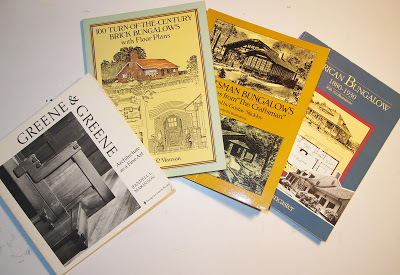
To these catalog reprints I added some architectural books devoted to certain types of residences – shingle style, prairie style, Victorian, and a lot of books on my favorite style – bungalows. I have number of books on bungalows down through the ages. Including the classics of Gustav Stickley’s Craftsman style homes and missionary style furnishings. Plus a book on Charles & Henry Greene’s famous California bungalows dating from the turn of the last century. One of their most famous bungalows was used in the Back to the Future film. I even have several years worth of American Bungalow magazine.


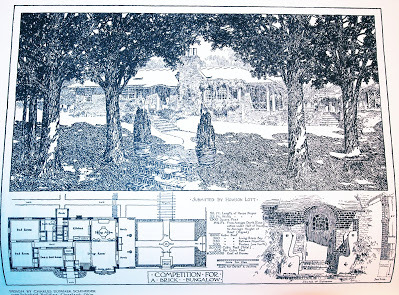
While the plans are interesting, I also enjoyed many of the books for the drawings and art that the architects used to showcase their house designs. I’ve included a few samples above, but there were many more that evoke a bygone age.

I often wondered what it would be like to live in houses like these, but wondering is as far as I'm ever going to get. Oh well.

The bottom picture on the above page is a large open room on the second floor that I thought would be really cool, especially if it was on a lake... And my little steam yacht was docked, down, beyond the terrace.
The book on the far left is called A Pattern Language, Towns, Buildings, Construction by Christopher Alexander, et al. It deserves a blog post of its own. If you're ever going to design a house, it is a book that you should look through. What they did was have people go all around the world and note the characteristics that made them feel comfortable, starting with what makes a city livable and working down to houses. From this study they proposed 253 "patterns." For houses these patterns range from #181 "There is no substitute for fire (i.e. fireplaces) #180 Window seats -- who doesn't like curling up with a book in a cozy seat next to a window. #196 Doors in the corners of rooms so that the traffic pattern does not run through the center of the room and conversational area. #203 Child caves .All kids like small places -- closets and such to hang out in. And all sorts of other observations. As I said, it's a blog post in itself. But it makes one think, and so often it made me say, "Yes, exactly. That's what I find attractive."
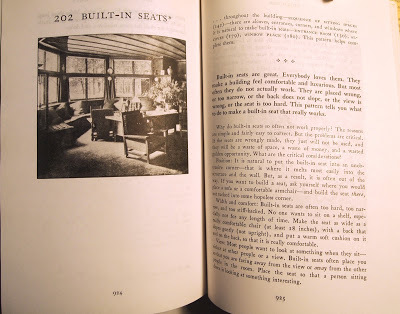
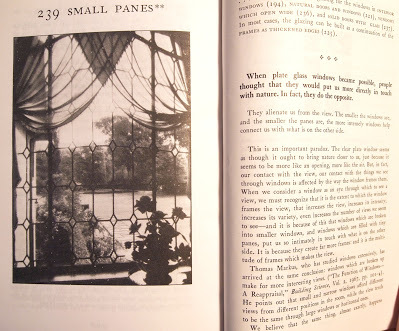
Anyway, that's my shelf of house plan books. One of those little passions of mine from my own bygone age. Though I have to admit it was fun paging through them again. I'll have to bring them out more often.
